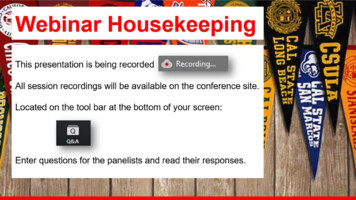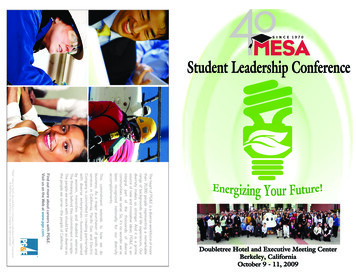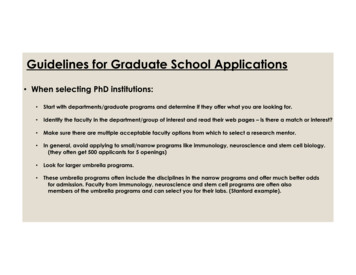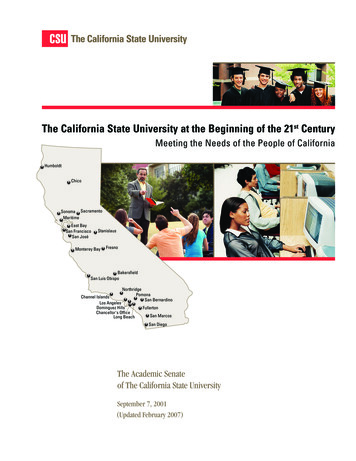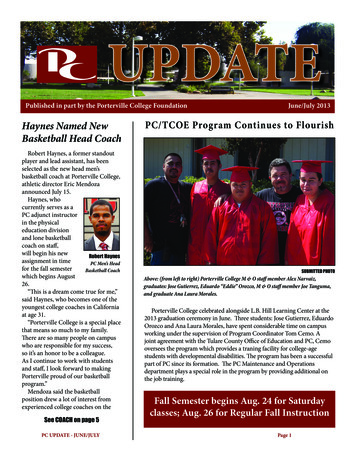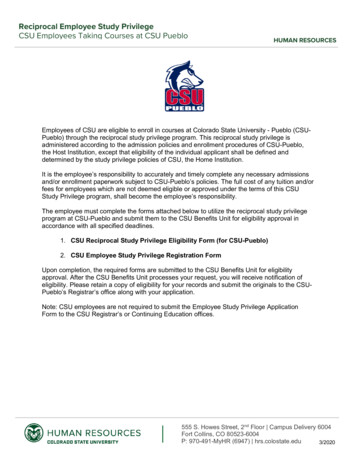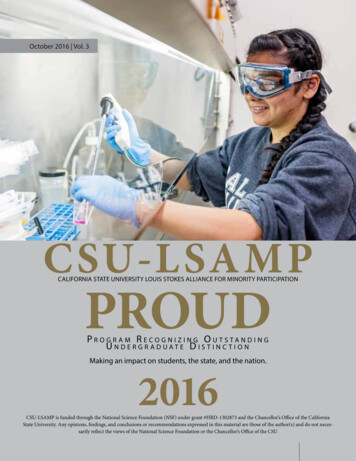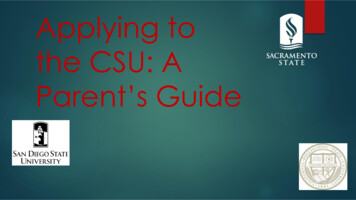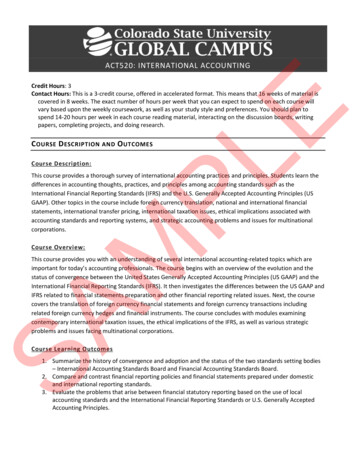
Transcription
ACT520: INTERNATIONAL ACCOUNTINGCourse Description:PLC OURSE D ESCRIPTION AND O UTCOMESECredit Hours: 3Contact Hours: This is a 3-credit course, offered in accelerated format. This means that 16 weeks of material iscovered in 8 weeks. The exact number of hours per week that you can expect to spend on each course willvary based upon the weekly coursework, as well as your study style and preferences. You should plan tospend 14-20 hours per week in each course reading material, interacting on the discussion boards, writingpapers, completing projects, and doing research.This course provides a thorough survey of international accounting practices and principles. Students learn thedifferences in accounting thoughts, practices, and principles among accounting standards such as theInternational Financial Reporting Standards (IFRS) and the U.S. Generally Accepted Accounting Principles (USGAAP). Other topics in the course include foreign currency translation, national and international financialstatements, international transfer pricing, international taxation issues, ethical implications associated withaccounting standards and reporting systems, and strategic accounting problems and issues for multinationalcorporations.MCourse Overview:SAThis course provides you with an understanding of several international accounting-related topics which areimportant for today’s accounting professionals. The course begins with an overview of the evolution and thestatus of convergence between the United States Generally Accepted Accounting Principles (US GAAP) and theInternational Financial Reporting Standards (IFRS). It then investigates the differences between the US GAAP andIFRS related to financial statements preparation and other financial reporting related issues. Next, the coursecovers the translation of foreign currency financial statements and foreign currency transactions includingrelated foreign currency hedges and financial instruments. The course concludes with modules examiningcontemporary international taxation issues, the ethical implications of the IFRS, as well as various strategicproblems and issues facing multinational corporations.Course Learning Outcomes1. Summarize the history of convergence and adoption and the status of the two standards setting bodies– International Accounting Standards Board and Financial Accounting Standards Board.2. Compare and contrast financial reporting policies and financial statements prepared under domesticand international reporting standards.3. Evaluate the problems that arise between financial statutory reporting based on the use of localaccounting standards and the International Financial Reporting Standards or U.S. Generally AcceptedAccounting Principles.
4. Analyze the impact of the global marketplace such as international customs, laws, and taxation policieson accounting for multinational organizations.5. Prepare foreign currency translation adjustments using translation methods.P ARTICIPATION & A TTENDANCEEPrompt and consistent attendance in your online courses is essential for your success at CSU-Global Campus.Failure to verify your attendance within the first 7 days of this course may result in your withdrawal. If for somereason you would like to drop a course, please contact your advisor.C OURSE M ATERIALSPLOnline classes have deadlines, assignments, and participation requirements just like on-campus classes. Budgetyour time carefully and keep an open line of communication with your instructor. If you are having technicalproblems, problems with your assignments, or other problems that are impeding your progress, let yourinstructor know as soon as possible.Textbook Information is located in the CSU-Global Booklist on the Student Portal.C OURSE S CHEDULEDue DatesThe Academic Week at CSU-Global begins on Monday and ends the following Sunday. Discussion Boards: The original post must be completed by Thursday at 11:59 p.m. MT and peerresponses posted by Sunday at 11:59 p.m. MT. Late posts may not be awarded points.Critical Thinking: Assignments are due Sunday at 11:59 p.m. MT.Live Classroom: Although participation is not required, Live Classroom sessions are held during Weeks 2and 7. There are two total sessions.M SAW EEKLY R EADING AND A SSIGNMENT D ETAILSModule 1Readings····Chapter 12 in Advanced Financial Accounting (p. 621 to the middle of p. 624)Guillaume, O., & Pierre, D. (2016). The convergence of U.S. GAAP with IFRS: A comparative analysisof principles-based and rules-based accounting standards. Scholedge International Journal ofBusiness Policy & Governance, 3(05), 63-72.McEnroe, J., & Sullivan, M. (2014). The rise and stall the U.S. GAAP and IFRS convergencemovement. The CPA Journal, 84(1), 14-19.Pacter, P. (2013). What have IASB and FASB convergence efforts achieved? (InternationalAccounting Standards Board). Journal of Accountancy, 215(2), 50-54, 56, 58-59.
···IASB-FASB convergence. (2019). Deloitte. Retrieved from iasb-fasb-convergenceKey differences between the US GAAP and IFRSs. (2019). Deloitte. Retrieved sgaapComparability in international accounting standards-a brief history. (n.d.). Financial AccountingStandards Board. Retrieved &cid 1176156304264Discussion (25 points)PLECritical Thinking (75 points)Choose one of the following two assignments to complete this week. Do not complete bothassignments. Identify your assignment choice in the title and on the Title Page and the file name of yoursubmission. Note that while there are two options for the Critical Thinking Assignment, there is only onerubric. Review the rubric to confirm you are meeting the assignment requirements. Please review theAPA Sample Research Paper provided in the assignment for the course expectations of what yourassignment submission should look like from a format point of view, not only for this Module, but alsofor any Research Paper or Writing Assignment throughout this course.Option #1: Revenue RecognitionThe FASB and the IASB reached convergence on revenue recognition, an important accounting subject,in recent years. You should do some research on how the convergence process evolved on thisaccounting subject before both standard-setters eventually issued their respective standards addressingthis subject. An online search will yield quite a bit of history and debate which occurred on thisaccounting subject between both the standard-setters and feedback from the public, including publiclylisted firms. You may be able to find, also, at the respective FASB and the IASB websites, informationrelated to the convergence process on this accounting subject.SAMAnswer the following questions specifically in your Word document submission by copying and pastingeach question in bold type with your answers below each question:1. Summarize in a few paragraphs the convergence process on this subject: How long did it take;was it contentious; what were the areas of disagreement as the convergence processdeveloped; and once the standard-setters converged, which side went further than the other, inyour opinion, to make the converged standard a reality?2. In your opinion, did the FASB and the IASB reach convergence on this accounting subject in theissuance of their respective new accounting standards?3. If no convergence was reached, what are the major differences that still exist on this accountingsubject between the FASB and the IASB? Be specific in identifying any major differences that stillexist, including but not limited to the potential impact on reported revenues and net income.4. In your opinion, how did the differences between rules-based and principle-based standardsinfluence the debate and ultimately the final standard issued by both standard-setters?5. Once the new accounting standard is implemented by companies around the world in thefuture, will we really be able to compare Company A in Industry Z reporting under IFRS toCompany B in Industry Z under the US GAAP? Explain in detail why or why not, justifying youropinion with specific details. You can even pick a specific company in a specific industry, if youwish, in preparing your answer to this question.6. Is either standard-setter still working on the implementation of the converged standard? If so,what are 1 or 2 of the key implementation matters which are still being developed with regardsto the new standard?
7. After doing your research for this Assignment Option, how has your opinion of convergence —the process, the goals, and the results to date — changed? Explain in detail.ERequirements: Write a paper of 4-6 pages in length, not counting the title and reference pages, which you mustinclude. Copy and paste each one of the Questions into your paper in bold type to ensure you haveanswered each of the Assignment Requirements. Use terms, evidence, and concepts from class readings, including professional businesslanguage. Cite at least 3 credible, academic or professional sources for this assignment, outside of thetextbook. The CSU-Global Library is a great place to find resources. Format your paper according to CSU-Global Guide to Writing and APA. Start with the links under the Research Help and Writing Help tabs on the CSU-Global Library’shomepage if you need assistance with writing style.PLReview the week’s CT Assignment grading rubric for more information on expectations and how you willbe graded.Option #2: Lease AccountingThe FASB and the IASB reached convergence on lease accounting, an important accounting subject, inrecent years. You should do some research on how the convergence process evolved on this accountingsubject before both standard-setters eventually issued their respective standards addressing thissubject. An online search will turn up quite a bit of history and debate which occurred on this accountingsubject between both standard-setters and feedback from the public, including publicly listed firms. Youalso may be able to find at the respective FASB and the IASB websites information related to theconvergence process on this accounting subject.SAMAnswer the following questions specifically in your Word document submission by copying and pastingeach question in bold type with your answers below each question:1. Summarize in a few paragraphs the convergence process on this subject: How long did it take;was it contentious; what were the areas of disagreement as the convergence processdeveloped; and once the standard-setters converged, which side went further than the other, inyour opinion, to make the converged standard a reality?2. In your opinion, did the FASB and the IASB reach convergence on this accounting subject in theissuance of their respective new accounting standards?3. If no convergence was reached, what are the major differences that still exist on this accountingsubject between the FASB and the IASB? Be specific in identifying any major differences that stillexist, including but not limited to the potential impact on reported revenues and net income.4. In your opinion, how did the differences between rules-based and principle-based standardsinfluence the debate and ultimately the final standard issued by both standard-setters?5. Once the new accounting standard is implemented by companies around the world in thefuture, will we really be able to compare Company A in Industry Z reporting under IFRS toCompany B in Industry Z under the US GAAP? Explain in detail why or why not, justifying youropinion with specific details. You can even pick a specific company in a specific industry, if youwish, in preparing your answer to this question.6. Is either standard-setter still working on the implementation of the converged standard? If so,what are 1 or 2 of the key implementation matters which are still being developed with regardsto the new standard?
7. After doing your research for this Assignment Option, how has your opinion of convergence —the process, the goals, and the results to date — changed? Explain in detail.ERequirements: Write a paper of 4-6 pages in length, not counting the title and reference pages, which you mustinclude. Copy and paste each one of the Questions into your paper in bold type to ensure you haveanswered each of the Assignment Requirements. Use terms, evidence, and concepts from class readings, including professional businesslanguage. Cite at least 3 credible, academic or professional sources for this assignment, outside of thetextbook. The CSU-Global Library is a great place to find resources. Format your paper according to CSU-Global Guide to Writing and APA. Start with the links under the Research Help and Writing Help tabs on the CSU-Global Library’shomepage if you need assistance with writing style.Module 2ReadingsPwC. (2018). IFRS and US GAAP: Similarities and differences. Retrieved d-differences.pdf· Chapter 2: Section 2-1 to 2-3: First Time IFRS Adoption· Chapter 14: Section 14.1 to 14.29-Other Accounting and Reporting Topics (includingdifferences between the IFRS and US GAAP related to the basic financial statements andother financial statement reporting issues)Key Differences Between U.S GAAP and IFRS. (2018). Retrieved from Harris, P. (2013). U.S. GAAP conversion to IFRS: A comprehensive case study. (United StatesGenerally Accepted Accounting Principles and International Financial Reporting Standards) (Casestudy). Internal Auditing, 28(3), 31-41.Ernst & Young Foundation. (2015). Financial statements - lecture notes.M·PLReview the week’s CT Assignment grading rubric for more information on expectations and how you willbe graded.··SA·Discussion (25 points)Live Classroom (0 points)Critical Thinking (75 points)Choose one of the following two assignments to complete this week. Do not complete bothassignments. Identify your assignment choice in the title of your submission. Note that while there aretwo options for the Critical Thinking Assignment, there is only one rubric. Review the rubric to confirmyou are meeting the assignment requirements.Option #1: Mercedes BenzAccess Mercedes Benz (MB)’s 2017 Annual Report prepared under IFRS in the assignment prompt. Thenpick any two of the financial statements: the consolidated balance sheet (statement of financialposition), the consolidated income statement (statement of income or statement of comprehensive
income), or the statement of cash flows for MB. Recast the two selected financial statements andpresent the statements following/in accordance with the US GAAP, presentation-wise, as accurately asyou can (you do not need to restate any of the results for MB in this process — just work with theresults as presented). The recasted financial statements should be an Exhibit or Appendix to your paper.Describe in an appropriate level of detail the differences that resulted when you recasted your chosenfinancial statements from the IFRS to US GAAP, supported with references from the readings in thismodule or outside references, where appropriate.PLERequirements: Write a paper of 3-4 pages in length, not counting the title and reference pages, which you mustinclude. The recasted financial statements should be an Exhibit or Appendix to your paper. Use terms, evidence, and concepts from class readings, including professional businesslanguage. Cite at least 3 credible, academic or professional sources for this assignment, outside of thetextbook. The CSU-Global Library is a great place to find resources. Format your paper according to CSU-Global Guide to Writing and APA. Start with the links under the Research Help and Writing Help tabs on the CSU-Global Library’shomepage if you need assistance with writing style.Review the week’s CT Assignment grading rubric for more information on expectations and how you willbe graded.MOption #2: Ford Motor CompanyAccess the Ford 2017 Annual Report prepared under the US GAAP in the assignment prompt. Then pickany two of the financial statements: the consolidated balance sheet (statement of financial position),the consolidated income statement (statement of income or statement of comprehensive income), orthe statement of cash flows for Ford. Recast the two selected financial statements and present thestatements following/in accordance with the IFRS, presentation-wise, as accurately as you can (you donot need to restate any of the results for Ford in this process — just work with the results as presented).Describe in an appropriate level of detail the differences that resulted when you recasted your chosenfinancial statements from the US GAAP to the IFRS, supported with references from the readings in thismodule or outside references, where appropriate.SARequirements: Write a paper of 3-4 pages in length, not counting the title and reference pages, which you mustinclude. The recasted financial statements should be an Exhibit or Appendix to your paper. Use terms, evidence, and concepts from class readings, including professional businesslanguage. Cite at least 3 credible, academic or professional sources for this assignment, outside of thetextbook. The CSU-Global Library is a great place to find resources. Format your paper according to CSU-Global Guide to Writing and APA. Start with the links under the Research Help and Writing Help tabs on the CSU-Global Library’shomepage if you need assistance with writing style.Review the week’s CT Assignment grading rubric for more information on expectations and how you willbe graded.Portfolio Milestone (20 points)
Topic Selection and RationaleSubmit your Portfolio Topic to your instructor for preliminary approval. Provide detailed reasons foryour Portfolio Project Option choice. Your submission should contain no more than 1 page of content,double-spaced, framed by a cover page and a reference page, if required. This assignment is requiredand is worth 20 points. Your submission must be made by Sunday night at the end of this Module topotentially earn these 20 points. Late submissions earn zero points.Module 3PLEReadings· Chapter 11 in Advanced Financial Accounting (pp. 548-556, which covers Multinational Accountingincluding the Accounting Issues related to Foreign Currency Exchange Rates)· Chapter 12 in Advanced Financial Accounting (pp. 621-650, Multinational Accounting Issues inFinancial Reporting and Translation of Foreign Entity Financial Statements; and pp. 653-656,Disclosure Requirements Under ASC830)· Ernst & Young Foundation. (2017). Foreign currency - lecture notes.· Ernst & Young Foundation. (2017). Foreign current - PowerPoint presentation.Discussion (25 points)Critical Thinking (75 points)Choose one of the following two assignments to complete this week. Do not complete bothassignments. Identify your assignment choice in the title of your submission. Note that while there aretwo options for the Critical Thinking Assignment, there is only one rubric. Review the rubric to confirmyou are meeting the assignment requirements.MOption #1: Schedule Preparation (British Pounds)On January 1, 20X8, Pace Company acquired all of the outstanding stock of Spin PLC, a British company,for 350,000. Spin's net assets on the date of acquisition were 250,000 pounds ( ). On January 1, 20X8,the book and fair values of the Spin's identifiable assets and liabilities approximated their fair valuesexcept for property, plant, and equipment and trademarks. The fair value of Spin's property, plant, andequipment exceeded its book value by 25,000. The remaining useful life of Spin's equipment at January1, 20X8, was 10 years. The remainder of the differential was attributable to a trademark having anestimated useful life of 5 years. Spin's trial balance on December 31, 20X8, in pounds, follows:SADebitsCash 70,000Accounts Receivable (net)100,000Inventory120,000Property, Plant, and Equipment330,000Accumulated DepreciationAccounts PayableCredits 120,000110,000Notes Payable90,000Common Stock100,000
Retained Earnings150,000Sales420,000Cost of Goods Sold270,000Operating Expenses60,000Depreciation Expense30,000Dividends Paid10,000 990,000 990,000ETotalMarch 1, 20X6MDecember 31, 20X7PLAdditional Information: Spin uses the FIFO method for its inventory. The beginning inventory was acquired on December31, 20X7, and ending inventory was acquired on December 26, 20X8. Purchases of 300,000were made evenly throughout 20X8. Spin acquired all of its property, plant, and equipment on March 1, 20X6, and uses straight-linedepreciation. Spin's sales were made evenly throughout 20X8, and its operating expenses were incurredevenly throughout 20X8. The dividends were declared and paid on November 1, 20X8. Pace's income from its own operations was 150,000 for 20X8, and its total stockholders' equityon January 1, 20X8, was 1,000,000. Pace declared 50,000 of dividends during 20X8. Exchange rates were as follows:1 1.201 1.251 1.25November 1, 20X81 1.26December 26, 20X81 1.31December 31, 20X81 1.35Average for 20X81 1.30SAJanuary 1, 20X8Required:1. Prepare a schedule translating the trial balance from British pounds into U.S. dollars. Assumethe pound is the functional currency.2. Assume that Pace uses the fully adjusted equity method. Record all journal entries that relate toits investment in the British subsidiary during 20X8. Provide the necessary documentation andsupport for the amounts in the journal entries, including a schedule of the translationadjustment related to the differential.3. Prepare a schedule that determines Pace's consolidated comprehensive income for 20X8.Prepare and submit only one Excel spreadsheet answering all of the requirements.
Use Excel formulas to make or evidence each of your calculations of each/any dollar amounts. Do notenter any dollar amounts, directly, for the answers to the requirements unless it is unavoidable forobvious reasons. Use the tab function at the bottom of the Excel file where required to answer each ofthe requirements.Name your Excel file when you submit it: MyNameModuleXOption1or2.ERequirements: Show calculations for all questions. Support writing portion of the assignment (if applicable) with credible sources. Use terms, evidence, and concepts from class readings, including professional businesslanguage.Review the week’s CT Assignment grading rubric for more information on expectations and how you willbe graded.PLOption #2: Schedule Preparation (Norwegian Kroner)On January 1, 20X5, P Company acquired all of the outstanding stock of S PLC, a Norwegian company,for 151,200. S's net assets on the date of acquisition were 700,000 kroner (Nkr). On January 1, 20X5,the book and fair values of S's identifiable assets and liabilities approximated their fair values except forproperty, plant, and equipment and trademarks. The fair value of S's property, plant, and equipmentexceeded its book value by 18,000. The remaining useful life of S's equipment at January 1, 20X5, was10 years. The remainder of the differential was attributable to a trademark having an estimated usefullife of 5 years. Spin's trial balance on December 31, 20X5, in kroner, ccounts Receivable (net)InventoryProperty, Plant, and EquipmentAccumulated DepreciationAccounts PayableNotes PayableCommon StockRetained EarningsSalesCost of Goods SoldOperating ExpensesDepreciation ExpenseDividends 690,000410,000100,00050,00040,0001,820,000 1,820,000Additional Information:1. S uses the FIFO method for its inventory. The beginning inventory was acquired on December31, 20X4, and ending inventory was acquired on December 15, 20X5. Purchases of NKr420,000were made evenly throughout 20X5.2. S acquired all of its property, plant, and equipment on July 1, 20X3, and uses straight-linedepreciation.3. S's sales were made evenly throughout 20X5, and its operating expenses were incurred evenlythroughout 20X5.
0.15December 30, 20X4 0.18January 1, 20X5 0.18July 1, 20X5 0.19December 15, 20X5 0.205PLJuly 1, 20X3E4. The dividends were declared and paid on July 1, 20X5.5. P's income from its own operations was 275,000 for 20X5, and its total stockholders' equity onJanuary 1, 20X5, was 3,500,000. P declared 100,000 of dividends during 20X5.6. Exchange rates were as follows (Nkr 1 ):December 31, 20X5 0.21Average for 20X5 0.20MRequired:1. Prepare a schedule translating the trial balance from Norwegian kroner into U.S. dollars. Assumethe kroner is the functional currency.2. Assume that P uses the fully adjusted equity method. Record all journal entries that relate to itsinvestment in the Norwegian subsidiary during 20X5. Provide the necessary documentation andsupport for the amounts in the journal entries, including a schedule of the translationadjustment related to the differential.3. Prepare a schedule that determines P's consolidated comprehensive income for 20X5.Prepare and submit only one Excel spreadsheet answering all of the requirements.SAUse Excel formulas to make or evidence each of your calculations of each/any dollar amounts. Do notenter any dollar amounts, directly, for the answers to the requirements unless it is unavoidable forobvious reasons. Use the tab function at the bottom of the Excel file where required to answer each ofthe requirements.Name your Excel file when you submit it: MyNameModuleXOption1or2.Requirements: Show calculations for all questions. Support writing portion of the assignment (if applicable) with credible sources. Use terms, evidence, and concepts from class readings, including professional businesslanguage.Review the week’s CT Assignment grading rubric for more information on expectations and how you willbe graded.
Module 4Readings···Chapter 11 in Advanced Financial Accounting (pp. 548-573)Chapter 11 PowerPoint LectureDeloitte Global Services Limited. (2018). Key differences between the US GAAP and IFRS. Retrievedfrom pFinancial Accounting Standards Board. (2017). Derivatives and hedging (Topic 815). Retrieved fromhttp://www.fasb.org/jsp/FASB/Document C/DocumentPage?cid 1176169282347&acceptedDisclaimer true.Read pp. 1-8, which summarize the 405-page document issued by the FASB.PwC. (2018). IFRS and US GAAP: Similarities and differences. Retrieved d-differences.pdf (Read the following in Chapter 11: Section 11.1 through 11-3.)E···PLDiscussion (25 points)Critical Thinking (75 points)Choose one of the following two assignments to complete this week. Do not complete bothassignments. Identify your assignment choice in the title of your submission. Note that while there aretwo options for the Critical Thinking Assignment, there is only one rubric. Review the rubric to confirmyou are meeting the assignment requirements.MOption #1: Journal Entries (Fair Value Hedge)On December 1, 20X8, Denizen Corporation entered into a 120-day forward contract to purchase200,000 Canadian dollars (C ). Denizen's fiscal year ends on December 31. The forward contract was tohedge a firm commitment agreement made on December 1, 20X8, to purchase electronic goods onJanuary 30, with payment due on March 31, 20X8. The derivative is designated as a fair value hedge. Thedirect exchange rates follow:Forward Rate forMarch 1, 20X9December 1, 20X80.9400.944December 31, 20X80.9450.947January 30, 20X90.9420.943March 31, 20X90.941SASpot RateRequired:Prepare all journal entries for Denizen Corporation.Requirements: Write a paper of 3-4 pages in length, not counting the title and reference pages, which you mustinclude. Use terms, evidence, and concepts from class readings, including professional businesslanguage.
Cite at least 3 credible, academic or professional sources for this assignment, outside of thetextbook. The CSU-Global Library is a great place to find resources.Format your paper according to CSU-Global Guide to Writing and APA.Start with the links under the Research Help and Writing Help tabs on the CSU-Global Library’shomepage if you need assistance with writing style.Review the week’s CT Assignment grading rubric for more information on expectations and how you willbe graded.EOption #2: Journal Entries (Cash Flow Hedge)On December 1, 20X8, Denizen Corporation entered into a 120-day forward contract to purchase200,000 Canadian dollars (C ). Denizen's fiscal year ends on December 31. The forward contract was tohedge an anticipated purchase of electronic goods on January 30, 20X9. The purchase took place onJanuary 30, with payment due on March 31, 20X9. The derivative is designated as a cash flow hedge. Thecompany uses the forward exchange rate to measure hedge effectiveness. The direct exchange ratesfollow:December 31, 20X8January 30, 20X9March 31, 20X90.9400.9440.9450.9470.9420.943PLDecember 1, 20X8Spot RateForward Rate forMarch 1, 20X90.941MRequired:Prepare all journal entries for Denizen Corporation.SARequirements: Write a paper of 3-4 pages in length, not counting the title and reference pages, which you mustinclude. Use terms, evidence, and concepts from class readings, including professional businesslanguage. Cite at least 3 credible, academic or professional sources for this assignment, outside of thetextbook. The CSU-Global Library is a great place to find resources. Format your paper according to CSU-Global Guide to Writing and APA. Start with the links under the Research Help and Writing Help tabs on the CSU-Global Library’shomepage if you need assistance with writing style.Review the week’s CT Assignment grading rubric for more information on expectations and how you willbe graded.Portfolio Milestone (30 points)Outline and QuestionsYour submission must be made by Sund
The FASB and the IASB reached convergence on lease accounting, an important accounting subject, in recent years. You should do some research on how the convergence process evolved on this accounting subject before both standard-setters eventually issued their respective standards addressing this
